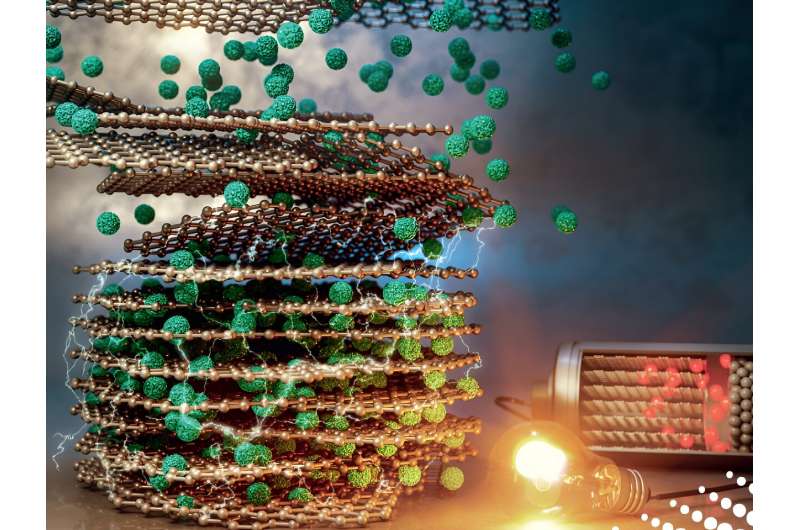This article has been reviewed according to Science X's editorial process and policies. Editors have highlighted the following attributes while ensuring the content's credibility:
fact-checked
peer-reviewed publication
trusted source
proofread
Thicker, denser, better: New electrodes may hold key to advanced batteries

The demand for high-performance batteries, especially for use in electric vehicles, is surging as the world shifts its energy consumption to a more electric-powered system, reducing reliance on fossil fuels and prioritizing climate remediation efforts. To improve battery performance and production, Penn State researchers and collaborators have developed a new fabrication approach that could make for more efficient batteries that maintain energy and power levels.
The improved method for fabricating battery electrodes may lead to high-performance batteries that would enable more energy-efficient electric vehicles, as well as such benefits as enhancing power grid storage, according to Hongtao Sun. Sun is an assistant professor of industrial and manufacturing engineering at Penn State, and the co-corresponding author of the study, which was published in and featured on the front cover of Carbon.
"With current batteries, we want them to enable us to drive a car for longer distances, and we want to charge the car in maybe five minutes, 10 minutes, comparable to the time it takes to fill up for gas," Sun said. "In our work, we considered how we can achieve this by making the electrodes and battery cells more compact, with a higher percentage of active components and lower percentage of passive components."
If an electric car maker wants to improve the driving distance of their vehicles, they add more battery cells, numbering in the thousands. The smaller and lighter, the better, according to Sun.
"The solution for longer driving distances for an electric vehicle is just to add compact batteries, but with denser and thicker electrodes," Sun said, explaining that such electrodes could better connect and power the battery's components, making them more active. "Although this approach may slightly reduce battery performance per electrode weight, it significantly enhances the vehicle's overall performance by reducing the battery package's weight and the energy required to move the electric vehicle."
More efficient electrodes—a kind of gateway for electricity in a battery—could help achieve a battery with a higher percentage of active components.
"If you think about the core components inside a battery, only the electrode contributes to the battery performance," Sun said. "The other parts like packaging, separator, current collector and so on, they are all passive components that add weight and do not contribute to the battery performance at all. If we want to improve the battery performance, we need to work on the battery electrode materials and maximize their weight percentage in a battery cell."
Prior attempts to improve battery performance via better electrodes focused on only one metric, which was not as effective because the battery then performed poorly on other trade-off metrics. For instance, when a battery prioritizes high gravimetric performance (the amount of energy it can store relative to its weight), it may result in reduced areal metric performance (how much charge it can store per unit area) and/or diminished volumetric performance (the amount of charge delivered relative to the battery's size).
Normally, batteries consist of anode and cathode thin-film electrodes set between two current conductor foils and separated by insulator separators. Increasing the thickness of these electrodes could improve energy storage capacity and density by providing more space for storing and releasing energy. A thicker electrode can store more charges and therefore, like a larger tank can hold more water, can hold more energy. However, they also have poor charge transport, which degrades their overall performance.
Sun and his research team focused on making thicker electrodes with optimized charge transport pathways, aiming to enable high performance across all three metrics: areal, volumetric and gravimetric.
To overcome the challenge of a thicker electrode having poor charge transport kinetics, the researchers developed a method to apply Spark Plasma Sintering (SPS) to electrodes. SPS is an energy-efficient technique that uses heat and pressure to compact and densify materials into a solid object, such as an electrode.
"SPS enabled us to fabricate a very thick and dense electrode," Sun said. "The typical thickness of the battery electrode is only about 50 microns to 100 microns but now, in this work, we are talking about 300 microns, 500 microns. That is five times higher than the proportion of mass of the electrode in a real battery device."
This technique achieves vertically aligned carbon networks and pore channels in the electrodes, enabling cathodes with high electrode density for high volumetric performance and high mass loading (amount of active material present) for high areal metric performance, while demonstrating rapid charge transports.
Using the researchers' newly designed thicker electrodes with fast charge transport capability would increase the percentage of active components and enhance the energy capacity normalized by the total weight of the battery package, Sun said. They also make the batteries compact due to the high density of the electrodes, which enables packing more electrode active materials within the same space.
According to Sun, the next steps in the research include developing a process to manufacture these electrodes in a scalable manner and investigating other strategies to decrease proportion of battery weight and enable more battery space in the vehicle.
"We are looking into how to develop structural batteries and how to integrate them into the structure of the vehicle," Sun said. "For example, we could integrate the battery into the roof of the electrical car, actually making it part of the structure. In that case, we can dramatically decrease the weight of the vehicle since we are combining function and structure."
More information: Bo Nie et al, Alignment does matter: Design thick electrodes to improve the comprehensive lithium storage performance, Carbon (2023). DOI: 10.1016/j.carbon.2023.02.015
















